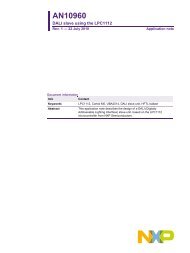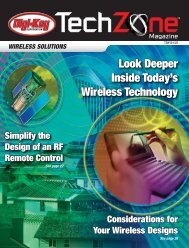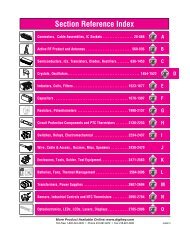Microcontroller Solutions TechZone Magazine, April 2011 - Digikey
Microcontroller Solutions TechZone Magazine, April 2011 - Digikey
Microcontroller Solutions TechZone Magazine, April 2011 - Digikey
You also want an ePaper? Increase the reach of your titles
YUMPU automatically turns print PDFs into web optimized ePapers that Google loves.
source code is open for those developers wishing for complete<br />
control. For each stack, a complete Programmer’s Guide is provided<br />
that serves as a reference for the API function calls and also<br />
describes the underlying concepts with clarity.<br />
Further, TI provides the MSP430 USB Descriptor Tool. This tool<br />
serves as a “control panel” for the API stacks, allowing for quick<br />
confi guration. It automatically creates the descriptors that every USB<br />
device must report to the host, based on user input. This saves the<br />
developer considerable time and provides peace of mind that the<br />
descriptors are done correctly.<br />
Stacks are available for the most common device classes and are<br />
supplied without additional charge. While developers should not<br />
underestimate what is required to create a robust USB interface,<br />
TI has signifi cantly shortened the USB learning curve. In this way,<br />
developers are freed of much of the burden of learning the intimate<br />
details of USB as a technology and instead are able to focus on using<br />
USB to increase the value and usability of their applications.<br />
Multiple device classes<br />
Part of the simplicity offered by the MSP430 USB API Stack is support<br />
for three device classes:<br />
Communications Device Class (CDC): The CDC presents the<br />
USB port to the PC application as a standard COM port. COM ports<br />
are popular interfaces that are fl exible, fast, and simple to use.<br />
Because it uses bulk transfers, the CDC provides high bandwidth<br />
with a reasonable amount of simplicity. The chief disadvantage of<br />
using the CDC is that developers must distribute a simple fi le to<br />
end users that allows it to be associated with the CDC driver built<br />
into Windows. Fortunately, the “new device detected” installation in<br />
Windows is fairly straightforward and a minor step already wellaccepted<br />
by end-users.<br />
Human Interface Device (HID): While HID is commonly thought of as<br />
primarily for mice and keyboards, it is a fl exible device class suitable<br />
for a wide variety of applications. TI’s HID API effi ciently generalizes<br />
HID capabilities, thereby eliminating the complexity associated with<br />
HID reports by allowing developers to access the interface in the<br />
exact same way they would a CDC device/COM port. While it has<br />
limited bandwidth (up to 64 KB/s), it requires no fi le to be distributed<br />
as CDC does, and it loads silently in Windows with no installation<br />
process required.<br />
Mass Storage Class (MSC): MSC is the device class used to<br />
implement the highly successful USB “fl ash drives,” as well as<br />
digital cameras and fl ash card readers. Since it is designed for<br />
moving large amounts of data, it provides higher bandwidth, similar<br />
to that of CDC. The tradeoff is more complexity – for example,<br />
developers will need to implement a fi le system – and the use of<br />
more code space. Like HID, MSC devices load silently in Windows<br />
without the need of an installation process. TI offers the MSC API<br />
layer at no cost. Given the wide variety of confi guration possibilities<br />
for software handling fi le systems, the different media types,<br />
and Flash management (i.e., through wear-leveling and other<br />
techniques), developers have the fl exibility of buying a commercial<br />
implementation or using one of the many open-source systems<br />
available for the MSP430.<br />
Of the three device classes, developers should begin by considering<br />
HID. If an application can work within the available 64 KB/s<br />
bandwidth, HID will often be the most cost-effective choice given<br />
that users can plug it in and use it without the need of an installation.<br />
Since the Windows installation process can sometimes lead to<br />
problems for the user, avoiding it can lead to a reduction of support<br />
calls and returns from customers.<br />
The TI USB API stacks support three data transfer types: control<br />
for USB-level control/status data, interrupt for low bandwidth,<br />
fi xed latency data, and bulk for high bandwidth, variable latency<br />
data. Usage of these data types is determined by the device class;<br />
developers need not concern themselves with most of the details<br />
associated with the different types.<br />
With these data types, the MSP430’s USB can support any application<br />
requiring control/confi guration, fi rmware updating, or that needs to<br />
transfer bulk data (as opposed to streaming data). The MSP430 does<br />
not support isochronous (high-bandwidth, fi xed latency) data, so it is<br />
not appropriate for streaming audio/video applications.<br />
Just as the MSP430 is fl exible, so is its USB functionality. Any USB<br />
device contains a certain number of what are called endpoints.<br />
Support for multiple endpoints allows for composite USB devices<br />
which can have more fl exible communication with hosts. For example,<br />
a device that uses the MSC for bulk data transfers and HID to manage<br />
control and status is comprised of three input and three output<br />
endpoints. The MSP430 architecture supports up to eight input and<br />
eight output endpoints, which provides suffi cient capacity for most<br />
applications without overburdening cost.<br />
Ultra-low-power efficiency<br />
By its nature, the MSP430 architecture has been optimized for<br />
low- power operation, both when USB is in use and when it is not. For<br />
example, MSP430 devices have fi ve low-power modes that enable<br />
designers to extend battery life in portable applications. The MSP430<br />
delivers high performance at the lowest power consumption with<br />
an active power consumption as low as 160 µA/MHz and 1.5 µA in<br />
standby mode coupled with fast wakeup from standby (less than<br />
5 microseconds) and a supply voltage as low as 1.8 V operation.<br />
The onboard DMA controller can also save signifi cant power when<br />
communicating with a battery-powered host.<br />
One of the advantages of USB in embedded applications is the<br />
ability to power devices over the interface. Ideally, battery-powered<br />
devices can maximize operating life by powering the device over<br />
the bus when attached to a host. As USB hosts source 5 V over the<br />
bus, an LDO is required to drop the voltage to the 3.3 V typical of ICs.<br />
MSP430 devices simplify power design and conserve board space by<br />
integrating an effi cient LDO as well as associated pull-up functionality.<br />
In addition to allowing MSP430s to operate directly from 5 V,<br />
integrating the LDO and pull-up resistors reduces component count<br />
and eliminates $.15 to $.20 relative to discrete implementations.<br />
By keeping the USB power and other MSP430 modules’ power<br />
management separate, the USB module can always be powered as<br />
long as the USB device is connected to the host. This also enables the<br />
USB module to auto-powerup the MSP430 via USB power even if the<br />
device battery is dead or non-existent.<br />
8














